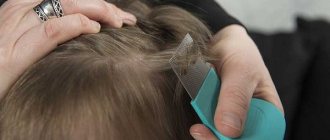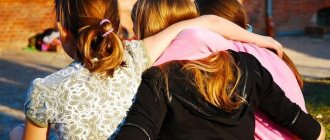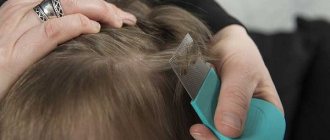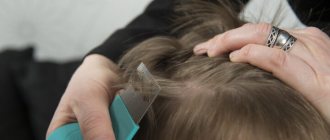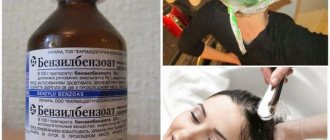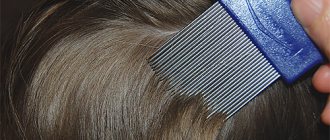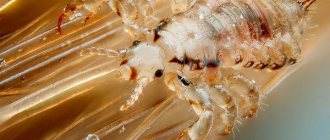Head lice are small parasitic creatures - insects that infect the hairy areas of the body. Their main diet consists of human blood, and when bitten, saliva is released, which causes a strong feeling of itching and irritation, as a result of which the child wants to scratch the skin. The process by which infection by these insects occurs is called pediculosis. Children are usually susceptible to it due to close contact with each other.
It is a mistake to believe that such a disease can only occur in representatives of the most shameful sections of the population. Indeed, the main cause of infection is neglect of the rules of personal hygiene, but even a clean city dweller can experience the presence of these parasites firsthand and understand what a louse is and what inconvenience it causes. Children often “bring” home uninvited guests from children's institutions, so prevention of lice in kindergartens, schools, and also at home is necessary.
Methods of transmission of pediculosis
There are several options for the disease to pass from one carrier to another.
- Close contact during outdoor games or educational work. For example, children sitting at the same desk can become infected with this disease.
- Through personal items - usually manifestation in this case occurs through bows, scarves and hats, combs.
- Regular visits to sections - gyms, swimming pools - entail an increased likelihood of contracting lice.
- Children's camps and other institutions that do not have good sanitary conditions suggest an increased likelihood of contracting the disease.
Prevention of lice and scabies in such places is a mandatory measure to prevent the appearance of these parasites.
Types of human lice
- Head parasites (affect the temporal and occipital parts, less often appear on the entire head);
- clothes insects live in clothes, in their seams and folds, sometimes they move onto the body to get food and bite the victim;
- Pubic lice usually live in the groin area, less often on other parts of the skin.
Appearance of lice and nits on hair
To know how not to become infected with this disease, it is necessary to study its main symptoms in order to quickly identify the carrier and source of the disease and take preventive measures.
Measures to combat pediculosis.
If you suspect body lice, you should contact a medical institution (polyclinic, skin and venereal disease dispensary), whose medical worker will submit an application to the Disinfection Station of the administrative district to carry out the treatment of things and the apartment, or contact the Disinfection Station at your place of residence.
In case of head lice, treatment can be carried out on your own, for which you need to buy an anti-pediculosis agent at a pharmacy or specialized store and treat the head strictly according to the instructions. After processing and washing your hair, for better removal (peel-off) of nits, you should moisten your hair with 9% table vinegar diluted in half with water and comb it thoroughly with a fine comb. If necessary, the treatment is repeated every 7 days until insects and nits are completely destroyed.
In the presence of skin diseases, allergies and in children under 5 years of age, when the use of anti-pediculosis drugs is not advisable, mechanical combing of lice and nits is carried out with a fine comb. For children, a haircut is possible.
Simultaneously with the treatment for pediculosis, underwear and bed linen are changed, followed by washing, linen and outerwear are ironed with steaming.
If you suspect pubic pediculosis, you should contact the skin and venereal disease clinic at your place of residence to treat and treat the consequences.
Symptoms of the disease in children
It can take several weeks from the moment the parasites hit the skin to complete infection, but recognizing the disease is not difficult.
- Severe itching in areas where lice bite;
- formation of a rash and red spots on the skin - on the scalp;
- the child begins to actively scratch the parasite bites, and scratching appears;
- You can find nits in your hair, and you can see them with the naked eye.
If it was not possible to prevent the formation of parasites, the first measures that need to be taken are to isolate them from the team (stop sending them to kindergarten, school, sports clubs and other public places). Treatment activities are carried out strictly on the basis of consultation with a specialist. But it is worth knowing that there are measures to prevent head lice that will allow you to prevent the occurrence of parasites yourself at home. Let's consider the main directions.
Preventive measures against pediculosis
To reduce risks, it is necessary to instruct the schoolchild or child about “what is good and what is bad.”
- A child should not give his own clothes to other children and wear someone else’s;
- It is not recommended to exchange personal belongings and toys;
- Girls’ long hair must be tied up in a ponytail or braids;
- if you want to send a child to a child care center, you need to make sure of the conditions;
- Regular boosting of the immune system minimizes the risks of infection;
- If this disease is detected in institutions, examine the child’s head;
- It is important to regularly carry out sanitary measures on linen and towels.
Adopting these rules will allow you to isolate yourself from lice and nits and avoid the occurrence of the disease.
Examining a child for pediculosis
Drug prevention of head lice in children
Today you can choose any product to prevent lice, because there are a lot of different sprays, shampoos and lotions for lice. The most popular means include:
- Hygia is an effective lice remedy, the use of which is not recommended for children under two years of age;
- Nittifof - cream for the prevention and treatment of pediculosis;
- Pedilin is another lice control drug available in the form of a gel or emulsion;
- Para Plus is a spray that can be used to disinfect clothing and bedding.
When using any shampoo to prevent head lice or one of the above remedies, be sure to thoroughly comb the child’s hair, first using a wide-tooth comb, and then a fine-tooth comb.
Means for preventing the disease
The modern cosmetic and pharmaceutical industry offers a wide selection of emulsions, gels and other formulations that can help prevent illness.
Products in the form of sprays
This form of products is good because they are easy to apply and quickly spread over the entire surface of the skin. In addition, they are safe in composition and easy to use.
- Steam Plus against lice is used to disinfect clothing and bedding;
- Paranit repellent - the drug contains anise oil, which helps repel uninvited guests. Protection is provided for a day, the product does not contain toxins and is 100% safe to use. The main goal is the prevention of childhood lice.
- A-steam is a disinfectant intended for treating a child’s bed linen, clothing, and other personal items. The product for lice prevention effectively destroys already existing parasites.
- Rosh Tov - the product contains essential oils and extracts of folk remedies - plants that have an antiseptic effect. Aims at preventing the disease and, if necessary, treating it.
- LiceGuard - this product is strictly preventative, has a scent that can repel insects, and is used to treat clothing.
When using these drugs, the likelihood of becoming infected with lice is reduced to zero.
Creams for preventive measures
- Nittifof is an effective cream used for preventive, therapeutic and rehabilitation procedures in relation to the disease.
- Nyx - a product made on the basis of permethrin, can be used for children over six months old. A single use of the composition provides protective measures for up to 6 weeks and high-quality treatment.
- Hygia - the product has a pronounced effect, but is not recommended for use for up to two years.
Shampoos against the appearance of lice
- NOC is an effective shampoo with a creamy consistency, approved for use by children over 2 years old.
- Biosim is a product made on the basis of the active ingredient permethrin, and is actively used for preventive measures for children from 5 years of age.
- Parasidosis can be used to eliminate lice and prevent them from the age of three months. The drug is based on cocamidopropyl and coconut acid, which have the properties to actively fight parasites.
- Pedilin is a low-risk drug for humans, but it effectively kills insects. If the composition comes into contact with the skin for a long time, an allergic reaction may occur.
Gels and emulsions
- Veda is an effective preventive remedy applied to damp hair until completely dry. Due to the possibility of allergic reactions, careful application must be ensured.
- Pedilin - available in the form of an emulsion or gel, effectively fights lice and nits.
After using any of the above remedies to prevent head lice, you need to carefully comb your baby’s hair using a wide-toothed comb, and then use a fine-toothed comb. If you wash your hair with such shampoos once every few weeks, you can provide protective properties against uninvited guests, as well as destroy those parasites that have already appeared (if this has happened).
It is important to know!
The use of a comb acts as a relatively effective non-chemical means of prevention. It is assumed that parasitic insects will be mechanically combed out.
Special lice comb
Pediculosis and its prevention
Pediculosis or lice is a specific parasitism of a person by lice that feed on his blood. Pediculosis has always been there.
The incidence of pediculosis tends to increase as a result of social and natural shocks, leading to disruption of normal life and a sharp deterioration in the sanitary and hygienic standard of living of the population. In recent years, there has been a trend toward a decrease in the incidence of head lice in the population as a whole, but the incidence of head lice among students in educational institutions is significant. The incidence of pediculosis in schoolchildren is associated with insufficient development of sanitary and hygienic skills in children and closer communication with each other, as well as the detection of pediculosis among this population, associated with examinations of children for preventive purposes for pediculosis (at least 5 times a year in accordance with the requirements regulatory documents.
The main symptoms of lice: itching, accompanied by scratching and, in some people, allergies; roughening of the skin from massive lice bites and the effects of insect saliva on the dermis; melasma - skin pigmentation due to tissue hemorrhages and an inflammatory process caused by exposure to insect saliva; mat is a rather rare phenomenon that forms when scratching the head - the hair gets tangled, stuck together with purulent-serous secretions, which dry out in crusts on the head, and underneath there is a weeping surface.
The risk group consists of people working in the service sector (hairdressers, baths, laundries, transport, medical institutions, etc.). The majority of head lice affect children of school age, but body lice affects people who do not have a permanent place of residence and lead a chaotic lifestyle.
There are three types of lice that parasitize humans: head, body, and pubic. Body lice and head lice are carriers of typhus, Volyn fever and relapsing fever. Body lice pose the greatest epidemic danger. A person becomes infected with typhus when secretions from an infected louse get into wounds where they scratch after a bite or when they crush an insect. The pubic louse has practically no epidemic significance, however, just like body and head lice, it causes great concern to a person, causing itching and leading to the risk of various pustular skin diseases.
The head louse is smaller than the body louse, the body length of the female is 2.1-3.5 millimeters, the male is 2.0-3.0 millimeters. The head louse lives and reproduces in the scalp, preferably on the temples, back of the head and crown. Feeds every 2-3 hours. It does not tolerate hunger well; at +30°C it usually dies within a day. The development of eggs occurs within 5-9 days, larvae - 15-17 days. The lifespan of adults is 27-30 days. The female lays 3-7 eggs daily. Outside the host's body, it dies within a day.
The body louse is larger than the head louse, the body length of the female is 2.3-4.75 mm, the male is 2.1-3.7 millimeters, the color is lighter. The body louse lives in the folds of linen and dresses, especially in the seams, where it lays eggs, gluing them to the fibers of the fabric; eggs can also stick to hair on the human body, except the head. Eats 2-3 times a day. Lays about 10 daily. Eggs develop within 7-14 days, larvae 14-18 days. The average lifespan of adults is 34 days, with a maximum of 46 days.
Pubic louse - body length 1.36-1.6 millimeters; The shape of the body resembles a shield, it is held on by short hairs of the pubis, eyebrows, and eyelashes. With significant numbers, insects can spread over the entire lower part of the body, especially on the stomach, where, as a result of their blood-sucking, characteristic bluish marks remain for a long time.
How does infection occur?
First of all, in close contact with people with lice, when communicating in kindergartens, schools, camps, in crowded transport, when using shared clothing, bedding, bedding, hats, combs and other personal items. Infection of pubic lice in adults occurs through intimate contact, and in children - from adults caring for them, as well as through underwear.
How to prevent pediculosis?
Not difficult. You just need to fulfill the usual personal hygiene requirements:
- washing your head and body with hot water and soap - at least once every 7 days
- change of bed linen and underwear - at least once every 7 days and when soiled
- washing clothes by boiling and then ironing with a hot iron
- regular haircut, combing of scalp hair
- weekly examinations for head lice for all family members
- systematic cleaning of outer dresses, clothes
- a complete ban on the use of other people's underwear, clothes, hats, combs and other personal hygiene items;
- regular cleaning of premises, keeping furnishings clean
- before wearing, pre-wash or iron new clothes and hats with a hot iron
What to do if lice or nits are found?
If lice are detected at any stage (egg, larva, adult insect), destruction measures should be carried out simultaneously, destroying lice directly both on the human body and on his underwear, clothes and other things. Treatment of people and their things with clothing or mixed lice is carried out only by the City Center for Disinfection and Sterilization, st. P. Brovki, 11. In case of head lice, a medical worker at a health care institution at the place of residence gives recommendations on mutual examination of family members, the use of anti-lice drugs (acting on lice and nits, recommended by the Ministry of Health of the Republic of Belarus) at home, or on carrying out sanitary treatment in Central sanitary checkpoint of the city Center for Disinfection and Sterilization, P. Brovki St., 11.
Measures to combat lice include three methods of exterminating insects:
- Mechanical method - in case of minor infestation of people with head lice (from 1 to 10 copies, including eggs), combing out insects and eggs with a fine comb, cutting and shaving the hair, followed by burning (in case of minor infestation with head lice).
- The physical method is soaking, boiling the linen in a 2% solution of soda ash for 15 minutes, ironing with a hot iron on both sides of the seams, folds, waistbands of the linen and clothes that are not subject to boiling (with minor head lice infestation).
- The chemical method of sanitation of pediculosis is currently based on the use of pediculicides - insecticides that act on lice and nits, recommended by the Ministry of Health of the Republic of Belarus, purchased in pharmacies and used in accordance with the instructions for this drug. This treatment is repeated after 7 days. After processing and washing the hair, rinse it with a warm 5-10% aqueous solution of acetic acid. Since dead nits remain on the hair, they need to be combed out with a comb and picked out with your hands. To prevent the spread of pediculosis (head lice can spread to clothing and the environment around a person), after completion of the sanitation it is necessary to disinfest the premises and furnishings: irrigate with an aqueous solution of pediculicide, maintain exposure (according to the instructions for use). Ventilate the room thoroughly. Remove pediculicide residues from treated objects and surfaces by wet cleaning as usual.
Where can you go for help if you are diagnosed with head lice?
For help, you can contact a medical professional at your place of residence, study, work, or directly to the sanitary checkpoint of the Minsk City Center for Disinfection and Sterilization at the address: Petrusya Brovki Street, 11 first floor, entrance 13, telephones: 2907567, 2920492, daily except Sunday, Monday , Thursday, Friday - from 8.00 to 18.00, Tuesday, Wednesday - from 14.00 to 18.00, on Saturday from 10.00 to 13.00.
The center has a room for anonymous examination and sanitation of pediculosis.
Remember!
Prevention and control of head lice are reliable means of preventing typhus. In order to prevent head lice, it is necessary to regularly examine all family members for head lice at home. If lice is detected in one of the family members, you need to make sure that the rest are not infected. For the purpose of prevention, it is recommended that all family members undergo treatment at the same time and carry out examinations of the scalp for the presence of lice within a month.
Doctor-epidemiologist of the anti-epidemic department of the epidemiological department of the state institution> "Center for Hygiene and Epidemiology of the Frunzensky District of Minsk" Olga Aleksandrovna Melentovich
Home prevention measures and actions
If a child attends public institutions, it is necessary to carry out home therapy to reduce the risk of infection.
- Every day, inspect the head for nits;
- braid tight braids or buns for girls;
- comb your hair thoroughly every day;
- cut your hair on a regular basis;
- teach your child the rules of hair hygiene;
- ensure timely change of linen and clothes;
- add folk preventive remedies to shampoo.
Safety precautions
What should parents do to reduce the risk of infection in their children?
First of all, from an early age, children must be taught personal hygiene.
It is very important to explain to your child that you cannot use other people’s combs, hairpins or hats.
If a child has lice or is bothered by itching or other symptoms, be sure to tell the parents so that they can examine the scalp.
If there is a sick child in the children's group, parents should wash the child's hair with one of the remedies for lice and nits as a preventive measure. The product must be used once every 2 weeks
It is during this period of time that adult insects develop from nits. And such prevention will prevent the appearance of lice, since adult insects will not be able to emerge from the nits.
Girls must braid their hair if they have long hair.
To avoid re-infection, you need to wash your bed linen, treat your pillow, blanket and mattress with a product against linen parasites.
For prevention, you can use tar soap, Biosim or Nix.
It is imperative to examine the hair of children who have vacationed in a camp or sanatorium.
If a child has lice, he is strictly prohibited from visiting childcare facilities.
Taking preventive measures in kindergarten
In preschool educational institutions, lice are a common occurrence, and everything is connected with a lack of awareness among parents about preventive measures. As part of the requirements and standards, the kindergarten must examine each child admitted, as well as conduct weekly checks. If there is an infestation, a number of measures must be taken.
- carry out activities such as the prevention of typhus;
- be sure to isolate infected children;
- examine all children who were in contact with carriers of the infection;
- provide information to the clinic serving the infected child;
- carry out thorough wet cleaning and disinfection measures;
- check all premises of the preschool educational institution for compliance with standards.
These measures will prevent large-scale lice and create favorable conditions for children.
